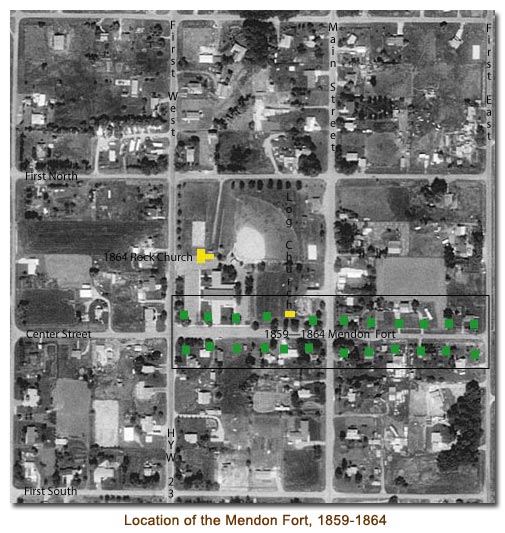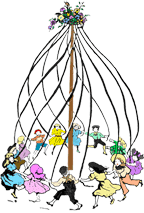Mendon Fort, 1859-1864
Mendon was not a fort in the strictest sense of the word, but it answered the purpose of a fort. It was built with a view for protection from the Indians that roamed the country at that time. Wagons were to be placed in the openings between the cabins to form the wall and to keep Indians from entering on their horses and gaining access to the rear guard of the pioneers. Fortunately this plan was not ever tested, but perhaps this is the case, because the Mendon Fort existed. Several arrows were fired at and into the Mendon Fort, one lodging in a mans hand as he stopped his horses from being stolen. A few animals and some food stuffs were stolen from Mendon, but that is the extent of the damage. Prevention proved to be better than cure in these unforgiving wild western times. Right here in Mendon, Utah!
The photograph map shows the approximate location of the cabins as they were laid out, while Mendon was restricted to living fort style. There were two rows of cabins facing each other across what would become todays Center Street, space was left in the center of the fort for the road that is now Main Street. I always smile when I think how Center & Main in pioneer times is still the reference point for the town of Mendon, Utah today. The cabins are marked with the small green squares, the first church was built inline with the cabins and is located as shown by the small yellow block. I also have included the location of the 1865 Rock Church, the T shaped yellow block. The first phase of the rock church was just the west portion of the building. Latter in 1887, they expanded the church into the T shape many of us remember, with the rocks and stones from the protective wall, that was constructed around the meeting house in the mid 1860's, This wall was what you could call a real fort, with port holes to fire from and bastions on the corners. It ended up not being needed as protection from Indians after all and the materials made a lovely addition to the church. The quality of the materials was not as good, I do not think as the first structure. As you view photographs of the 1864 meeting house look to see if you can tell a difference in construction materials.
When the old fort was broken up, many families moved the cabin they were living in to new locations on the city plat. A few were able to stay in the locations they had prior. The Birds, Richards, Hill (Sorensen Family) being some that I suppose were able stay in place. One of the cabins still exists today, Bishop Richard Watkins has the dissembled logs of the Peter Sorensen cabin. It is said that this cabin was part of the original Mendon Fort. I believe in time he hopes to reconstruct the cabin in a suitable place in the city. I look forward to seeing it stand once again.
![]()
Mendon Fort 1859 to 1864
In the spring and summer of 1859 came the greatest influx of pioneers to Mendon. About March 1st, Rodger Luckham with his two daughters, Mary and Susan, and Robert Sweeten, his stepson, Alfred and Charley Atkinson, two little Englishmen and their families, all from Mill Creek arrived here. Following them in quick succession were James G. Willie from Salt Lake, John and Hyrum J. Richards, James H. Hill and Peter Larsen all from Mill Creek. The Sorensen brothers [Peder & Isaac] residing at Maughan's Fort also came at this time. Then others arrived, among them Charles William Kelsey, Bradford Bird, Ralph Forster, Hans Jensen, William Findley, Charles and Andrew Shumway, Andrew Andersen, Jasper Lemmon, Manning Rowe, Henry Hughes, John Donaldson, James McBride, Winslow Farr, Gibson and Dabell the Baker brothers, Lorme Hancock, Gardner, Wood, Shelton, Stokes, Smyths and perhaps others.
In August 1859 Jessie W. Fox Sr., a surveyor from Salt Lake City surveyed and laid out the old fort, also the fields adjourning the fort. At this time the pioneers were all living in their tents and wagons. They now built their log houses and dugouts, the fort being about two and one half blocks long. The houses were built of logs the men going to the canyon or river bottom for them. They were either pine or cottonwood. The men usually went to the canyons or fields in companies so as to give better protection against the Indians.
This fort consisted of two rows of houses facing each other, running east and west, with a space or roadway between the two rows. About in the center of the fort a road ran north and south, this being the only opening to get through the fort. The houses consisted of one room with ground for the floor. The logs were hewn smooth on one side for the inside of the house, and placed one on top of the other to the square and clay was used to fill up the chinks.
The roof consisted of a number of straight saplings being placed close togaethr, then covered with a covering of long wheat grass or straw, when it could be obtained. Then a thick covering of dirt. In the back of each row of houses was a garden spot and back of this were the corrals and stockyards. Some of the people raised their gardens on their farming land.
The farming land reached to the south as far as the Mill Pond or what we now call Clayton. It reached north as far as Richards Spring, and east as far as the river.
Charles Shumway was authorized to take charge of the public affairs of the new settlement until his son, Andrew P. Shumway was ordained Bishop on December 18, 1859. The first meetings were held in private cabins during the winter. Rodger Luckham let the singing and Ira Ames played the fiddle. In the winter of 1859 and 1860 the men of the fort went to the canyons of Cache Valley both east an west to get fine logs with which to build a public house. The structure was 18 feet by 24 feet and served for worship, school and recreation.
In the spring of 1861 the United States Post Office was established here. In the spring of 1861 the men turned out in mass and built a dam across Gardner' Creek in which to irrigate their farms. The first Sunday school was held in 1863 with James G. Willie as superintendent. They lived in the fort five years then in the spring of 1864 a town plot was surveyed and the families moved from the old fort to their city lots.
The city was incorporated, March 12, 1870 -1910.1
![]()
![]()
1. Author Unknown, Mendon Fort 1859 to 1864, unpublished manuscript.
